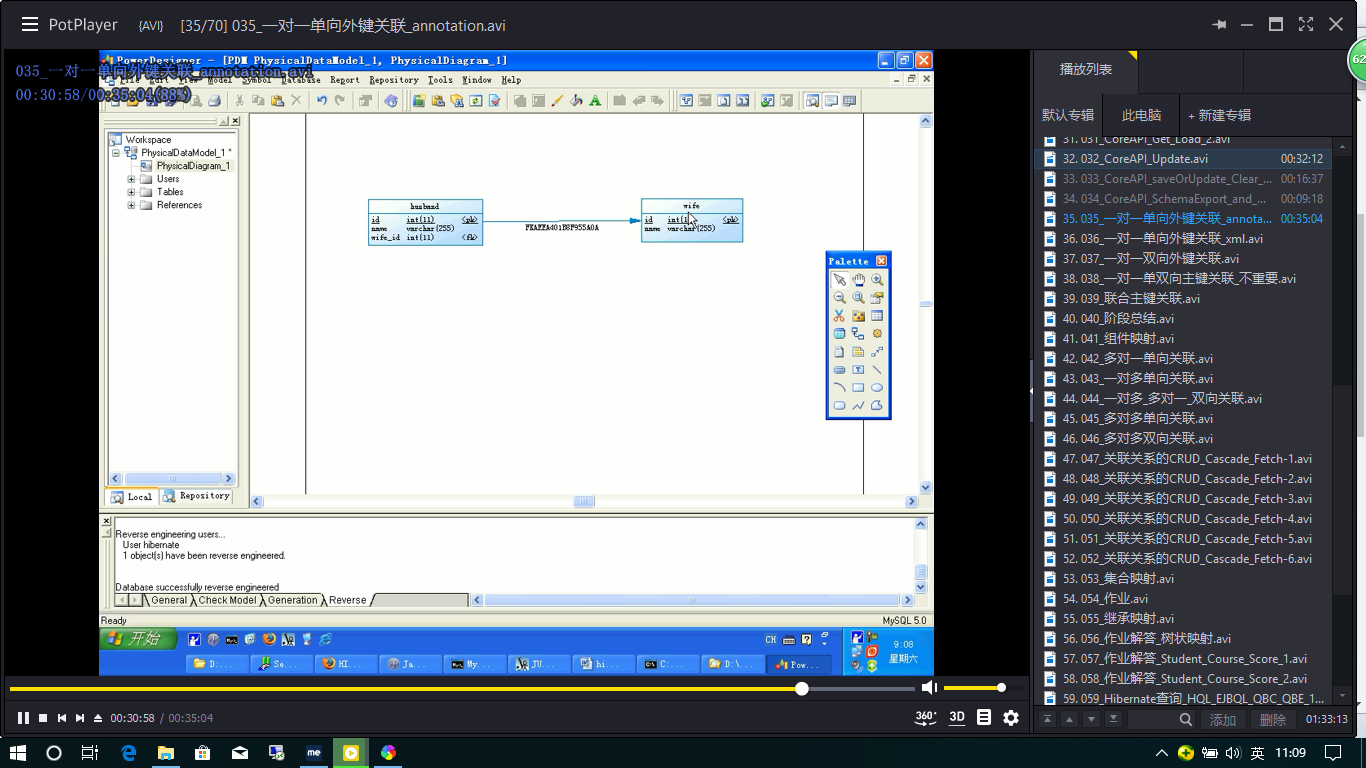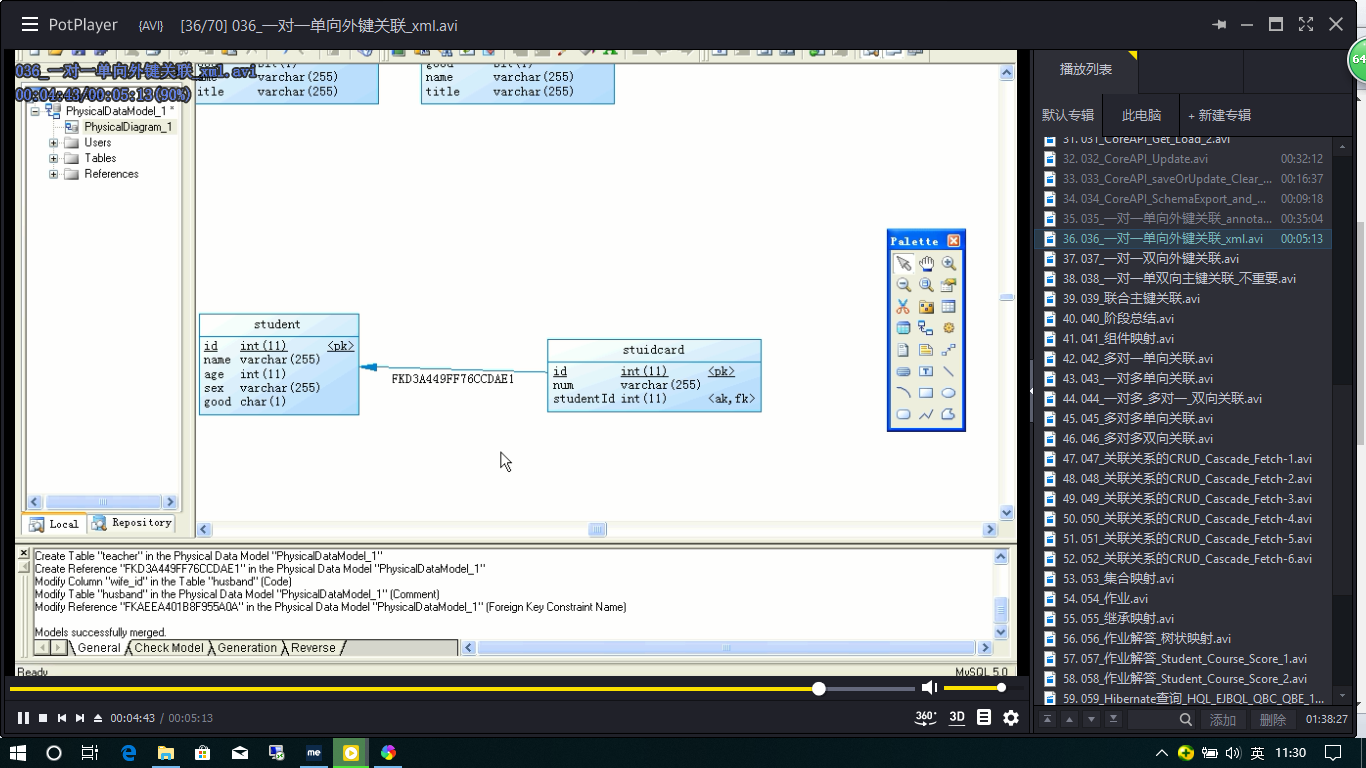Hibernate学习笔记3.1(Hibernate关系映射)
主要指对象之间的关系
1.一对一关联
一对一单项外键关联
比如说一夫一妻
Wifi.java
package com.bjsxt.hibernate; import javax.persistence.Entity;
import javax.persistence.GeneratedValue;
import javax.persistence.Id; @Entity
public class Wife {
private int id;
private String name; @Id
@GeneratedValue
public int getId() {
return id;
}
public void setId(int id) {
this.id = id;
}
public String getName() {
return name;
}
public void setName(String name) {
this.name = name;
} }
Huaband.java
package com.bjsxt.hibernate; import javax.persistence.Entity;
import javax.persistence.GeneratedValue;
import javax.persistence.Id;
import javax.persistence.JoinColumn;
import javax.persistence.OneToOne; @Entity
public class Husband {
private int id;
private String name;
private Wife wife;
@Id
@GeneratedValue
public int getId() {
return id;
} public String getName() {
return name;
}
@OneToOne
@JoinColumn(name="wifeId")
public Wife getWife() {
return wife;
}
public void setId(int id) {
this.id = id;
}
public void setName(String name) {
this.name = name;
}
public void setWife(Wife wife) {
this.wife = wife;
} }
hibernate.cfg.xml
<?xml version='1.0' encoding='utf-8'?>
<!DOCTYPE hibernate-configuration PUBLIC
"-//Hibernate/Hibernate Configuration DTD 3.0//EN"
"http://hibernate.sourceforge.net/hibernate-configuration-3.0.dtd"> <hibernate-configuration> <session-factory> <property name="connection.driver_class">com.mysql.jdbc.Driver</property>
<property name="connection.url">jdbc:mysql://localhost/hibernate</property>
<property name="connection.username">root</property>
<property name="connection.password">bjsxt</property>
<property name="dialect">org.hibernate.dialect.MySQLDialect</property>
<!--
<property name="connection.driver_class">oracle.jdbc.driver.OracleDriver</property>
<property name="connection.url">jdbc:oracle:thin:@localhost::SXT</property>
<property name="connection.username">scott</property>
<property name="connection.password">tiger</property>
<property name="dialect">org.hibernate.dialect.OracleDialect</property>
--> <!-- JDBC connection pool (use the built-in) -->
<property name="connection.pool_size"></property> <!-- Enable Hibernate's automatic session context management -->
<property name="current_session_context_class">thread</property> <!-- Disable the second-level cache -->
<property name="cache.provider_class">org.hibernate.cache.NoCacheProvider</property> <!-- Echo all executed SQL to stdout -->
<property name="show_sql">true</property>
<property name="format_sql">true</property> <!-- Drop and re-create the database schema on startup
<property name="hbm2ddl.auto">update</property>
-->
<!-- -->
<mapping resource="com/bjsxt/hibernate/Student.hbm.xml"/>
<mapping resource="com/bjsxt/hibernate/StuIdCard.hbm.xml"/>
<mapping class="com.bjsxt.hibernate.Husband"/>
<mapping class="com.bjsxt.hibernate.Wife"/> </session-factory> </hibernate-configuration>
test.java关键代码
@Test
public void testSchemaExport() {
new SchemaExport(new AnnotationConfiguration().configure()).create(false, true);
}
实际建表关系

@OneToOne
@JoinColumn(name="wifeId")
public Wife getWife() {
return wife;
}
public void setId(int id) {
this.id = id;
}
上面可以指定生成的列名
2.单向关联
Student.java
package com.bjsxt.hibernate;
public class Student {
private int id;
private String name;
private int age;
private String sex;
private boolean good;
public boolean isGood() {
return good;
}
public void setGood(boolean good) {
this.good = good;
}
public int getId() {
return id;
}
public void setId(int id) {
this.id = id;
}
public String getName() {
return name;
}
public void setName(String name) {
this.name = name;
}
public int getAge() {
return age;
}
public void setAge(int age) {
this.age = age;
}
public String getSex() {
return sex;
}
public void setSex(String sex) {
this.sex = sex;
}
}
StuIdCard.java
package com.bjsxt.hibernate;
public class StuIdCard {
private int id;
private String num;
private Student student;
public int getId() {
return id;
}
public void setId(int id) {
this.id = id;
}
public String getNum() {
return num;
}
public void setNum(String num) {
this.num = num;
}
public Student getStudent() {
return student;
}
public void setStudent(Student student) {
this.student = student;
}
}
StuIdCard.hbm.xml
<?xml version="1.0"?>
<!DOCTYPE hibernate-mapping PUBLIC
"-//Hibernate/Hibernate Mapping DTD 3.0//EN"
"http://hibernate.sourceforge.net/hibernate-mapping-3.0.dtd"> <hibernate-mapping>
<class name="com.bjsxt.hibernate.StuIdCard">
<id name="id">
<generator class="native"></generator>
</id> <property name="num"/>
<many-to-one name="student" column="studentId" unique="true"></many-to-one>
</class> </hibernate-mapping>
从字面上看是多对一 其实后面指定了unique 所以实际上是一对一
关系图

2.一对一双向外键关联
直接写@onetoone的话会导致产生两个外键
Husband.java
package com.bjsxt.hibernate; import javax.persistence.Entity;
import javax.persistence.GeneratedValue;
import javax.persistence.Id;
import javax.persistence.JoinColumn;
import javax.persistence.OneToOne; @Entity
public class Husband {
private int id;
private String name;
private Wife wife;
@Id
@GeneratedValue
public int getId() {
return id;
} public String getName() {
return name;
}
@OneToOne
@JoinColumn(name="wifeId")
public Wife getWife() {
return wife;
}
public void setId(int id) {
this.id = id;
}
public void setName(String name) {
this.name = name;
}
public void setWife(Wife wife) {
this.wife = wife;
} }
Wife.java
package com.bjsxt.hibernate; import javax.persistence.Entity;
import javax.persistence.GeneratedValue;
import javax.persistence.Id;
import javax.persistence.OneToOne; @Entity
public class Wife {
private int id;
private String name;
private Husband husband;
@OneToOne(mappedBy="wife") //在对方那里设置
public Husband getHusband() {
return husband;
}
public void setHusband(Husband husband) {
this.husband = husband;
}
@Id
@GeneratedValue
public int getId() {
return id;
}
public void setId(int id) {
this.id = id;
}
public String getName() {
return name;
}
public void setName(String name) {
this.name = name;
} }
只要有双向关联,必须设@OneToOne(mappedBy="wife")
告诉hibernate对方那里是主导
2.XML设置
Student.hbm.xml
<?xml version="1.0"?>
<!DOCTYPE hibernate-mapping PUBLIC
"-//Hibernate/Hibernate Mapping DTD 3.0//EN"
"http://hibernate.sourceforge.net/hibernate-mapping-3.0.dtd"> <hibernate-mapping>
<class name="com.bjsxt.hibernate.Student" dynamic-update="true">
<id name="id">
<generator class="native"></generator>
</id> <property name="name"></property>
<property name="age" />
<property name="sex" />
<property name="good" type="yes_no"></property>
<one-to-one name="stuIdCard" property-ref="student"></one-to-one>
</class> </hibernate-mapping>
一对一单向双向的区别:在数据库没什么区别 但是在Java程序中有区别 单向和双向的区别能否靠对方找到自己
4.一对一单向主键关联
Husband.java
package com.bjsxt.hibernate; import javax.persistence.Entity;
import javax.persistence.GeneratedValue;
import javax.persistence.Id;
import javax.persistence.JoinColumn;
import javax.persistence.OneToOne;
import javax.persistence.PrimaryKeyJoinColumn; @Entity
public class Husband {
private int id;
private String name;
private Wife wife;
@Id
@GeneratedValue
public int getId() {
return id;
} public String getName() {
return name;
}
@OneToOne
@PrimaryKeyJoinColumn
public Wife getWife() {
return wife;
}
public void setId(int id) {
this.id = id;
}
public void setName(String name) {
this.name = name;
}
public void setWife(Wife wife) {
this.wife = wife;
} }
wifi.java
package com.bjsxt.hibernate; import javax.persistence.Entity;
import javax.persistence.GeneratedValue;
import javax.persistence.Id; @Entity
public class Wife {
private int id;
private String name; @Id
@GeneratedValue
public int getId() {
return id;
}
public void setId(int id) {
this.id = id;
}
public String getName() {
return name;
}
public void setName(String name) {
this.name = name;
} }
测试
@Test
public void testSchemaExport() {
new SchemaExport(new AnnotationConfiguration().configure()).create(false, true);
}
但实际上并没有产生关联 这是一个bug
在xml里面配置正常
StuIdCard.hbm.xml
<?xml version="1.0"?>
<!DOCTYPE hibernate-mapping PUBLIC
"-//Hibernate/Hibernate Mapping DTD 3.0//EN"
"http://hibernate.sourceforge.net/hibernate-mapping-3.0.dtd"> <hibernate-mapping>
<class name="com.bjsxt.hibernate.StuIdCard">
<id name="id">
<generator class="foreign">
<param name="property">student</param>
</generator>
</id> <property name="num"/>
<one-to-one name="student" constrained="true"></one-to-one>
</class> </hibernate-mapping>
constrained = “true” 就可以加一个外键约束
在实际开发中,一对一很少,一对一主键也很少
一对一双向主键关联 不太重要 一般不使用 略
联合主键
Husband.java
package com.bjsxt.hibernate; import javax.persistence.Entity;
import javax.persistence.GeneratedValue;
import javax.persistence.Id;
import javax.persistence.JoinColumn;
import javax.persistence.JoinColumns;
import javax.persistence.OneToOne; @Entity
public class Husband {
private int id;
private String name;
private Wife wife;
@Id
@GeneratedValue
public int getId() {
return id;
} public String getName() {
return name;
}
@OneToOne
@JoinColumns(
{
@JoinColumn(name="wifeId", referencedColumnName="id"),
@JoinColumn(name="wifeName", referencedColumnName="name")
}
)
public Wife getWife() {
return wife;
}
public void setId(int id) {
this.id = id;
}
public void setName(String name) {
this.name = name;
}
public void setWife(Wife wife) {
this.wife = wife;
} }
Wife.java
package com.bjsxt.hibernate; import javax.persistence.Entity;
import javax.persistence.Id;
import javax.persistence.IdClass; @Entity
@IdClass(WifePK.class)
public class Wife {
private int id;
private String name;
private int age; public int getAge() {
return age;
}
public void setAge(int age) {
this.age = age;
}
@Id
public int getId() {
return id;
}
public void setId(int id) {
this.id = id;
}
@Id
public String getName() {
return name;
}
public void setName(String name) {
this.name = name;
} }
WifePK.java
package com.bjsxt.hibernate;
import java.io.Serializable;
public class WifePK implements Serializable {
private int id;
private String name;
public int getId() {
return id;
}
public void setId(int id) {
this.id = id;
}
public String getName() {
return name;
}
public void setName(String name) {
this.name = name;
}
}
hibernate.cfg.xml
<?xml version='1.0' encoding='utf-8'?>
<!DOCTYPE hibernate-configuration PUBLIC
"-//Hibernate/Hibernate Configuration DTD 3.0//EN"
"http://hibernate.sourceforge.net/hibernate-configuration-3.0.dtd"> <hibernate-configuration> <session-factory> <property name="connection.driver_class">com.mysql.jdbc.Driver</property>
<property name="connection.url">jdbc:mysql://localhost/hibernate</property>
<property name="connection.username">root</property>
<property name="connection.password">bjsxt</property>
<property name="dialect">org.hibernate.dialect.MySQLDialect</property>
<!--
<property name="connection.driver_class">oracle.jdbc.driver.OracleDriver</property>
<property name="connection.url">jdbc:oracle:thin:@localhost::SXT</property>
<property name="connection.username">scott</property>
<property name="connection.password">tiger</property>
<property name="dialect">org.hibernate.dialect.OracleDialect</property>
--> <!-- JDBC connection pool (use the built-in) -->
<property name="connection.pool_size"></property> <!-- Enable Hibernate's automatic session context management -->
<property name="current_session_context_class">thread</property> <!-- Disable the second-level cache -->
<property name="cache.provider_class">org.hibernate.cache.NoCacheProvider</property> <!-- Echo all executed SQL to stdout -->
<property name="show_sql">true</property>
<property name="format_sql">true</property> <!-- Drop and re-create the database schema on startup
<property name="hbm2ddl.auto">update</property>
-->
<!-- --> <mapping class="com.bjsxt.hibernate.Husband"/>
<mapping class="com.bjsxt.hibernate.Wife"/> </session-factory> </hibernate-configuration>
Test
package com.bjsxt.hibernate; import java.util.Date; import org.hibernate.Query;
import org.hibernate.Session;
import org.hibernate.SessionFactory;
import org.hibernate.cfg.AnnotationConfiguration;
import org.hibernate.tool.hbm2ddl.SchemaExport;
import org.junit.AfterClass;
import org.junit.BeforeClass;
import org.junit.Test; public class HibernateORMappingTest {
private static SessionFactory sessionFactory; //@BeforeClass
public static void beforeClass() {
sessionFactory = new AnnotationConfiguration().configure().buildSessionFactory();
}
//@AfterClass
public static void afterClass() {
sessionFactory.close();
} @Test
public void testSchemaExport() {
new SchemaExport(new AnnotationConfiguration().configure()).create(false, true);
} public static void main(String[] args) {
beforeClass();
}
}
Hibernate学习笔记3.1(Hibernate关系映射)的更多相关文章
- Hibernate学习笔记三:对象关系映射(一对一,一对多,多对一,多对多)
如需转载,请说明出处:http://www.cnblogs.com/gudu1/p/6895610.html Hibernate通过关系映射来表示数据库中表与表之间的关系,关系映射可以通过两种方式:配 ...
- Hibernate学习笔记(四)关系映射之一对一关联映射
一. 一对一关联映射 ² 两个对象之间是一对一的关系,如Person-IdCard(人—身份证号) ² 有两种策略可以实现一对一的关联映射 Ø 主键关联:即让 ...
- Hibernate学习笔记(五) — 多对多关系映射
多对多关系映射 多对多建立关系相当于在第三张表中插入一行数据 多对多解除关系相当于在第三张表中删除一行数据 多对多改动关系相当于在第三张表中先删除后添加 多对多谁维护效率都一样.看需求 在实际开发过程 ...
- HIbernate学习笔记(六) 关系映射之多对多
六.多对多 - 单向 Ø 一般的设计中,多对多关联映射,需要一个中间表 Ø Hibernate会自动生成中间表 Ø Hibernate使用many-to-ma ...
- HIbernate学习笔记(五) 关系映射之一对多与多对一
三. 多对一 –单向 场景:用户和组:从用户角度来,多个用户属于一个组(多对一 关联) 使用hibernate开发的思路:先建立对象模型(领域模型),把实体抽取出来. 目前两个实体:用户和 ...
- hibernate学习(设计一对多 关系 映射)
1,配置文件: <?xml version="1.0" encoding="UTF-8"?> <!DOCTYPE hibernate-conf ...
- Hibernate学习笔记二:Hibernate缓存策略详解
一:为什么使用Hibernate缓存: Hibernate是一个持久层框架,经常访问物理数据库. 为了降低应用程序访问物理数据库的频次,从而提高应用程序的性能. 缓存内的数据是对物理数据源的复制,应用 ...
- hibernate学习(设计多对多 关系 映射)
// package org.crazy.app.domain; import java.util.HashSet; import java.util.Set; import javax.persis ...
- Hibernate学习笔记--第一个Hibernate框架程序
一般使用集成开发环境是,把所需的类库添加到项目属性的库路径中,开发工具在部署时会自动复制所需要的类包到WEB-INF\lib目录下 MyEclipse中: 创建项目,右击项目->myeclips ...
- Hibernate学习笔记(二)
2016/4/22 23:19:44 Hibernate学习笔记(二) 1.1 Hibernate的持久化类状态 1.1.1 Hibernate的持久化类状态 持久化:就是一个实体类与数据库表建立了映 ...
随机推荐
- POI实现导出Excel和模板导出Excel
一.导出过程 1.用户请求导出 2.先访问数据库,查询需要导出的结果集 3.创建导出的Excel工作簿 4.遍历结果集,写入工作簿 5.将Excel已文件下载的形式回复给请求客户端 二.具体实现(截取 ...
- AS导入项目报错:Plugin with id 'com.android.application' not found.
从github或第三方Demo中获取的项目导入到AndroidStudio中报错Plugin with id 'com.android.application' not found.:今天导入一个讯飞 ...
- 测试oracle数据库连接
1.ping 192.168.0.12.telnet 192.168.0.1 1521 按下ctrl+] 组合键出现命令回显才是端口连接成 3.tnsping 192.168.0.1:1521/db
- Kettle性能调优汇总
性能调优在整个工程中是非常重要的,也是非常有必要的.但有的时候我们往往都不知道如何对性能进行调优.其实性能调优主要分两个方面:一方面是硬件调优,一方面是软件调优.本章主要是介绍Kettle的性能优 ...
- 自动创建表出错 type=InnDB
因为type=InnoDB在5.0以前是可以使用的,但5.1之后就不行了 只需要修改配置: hibernate.dialect=org.hibernate.dialect.MySQLInnoDBDia ...
- SQL server约束
约束的概念:确保在列中输入有效的值并维护表之间的关系. Primary key约束 功能:primary key(主键约束),一个表中只能有一个,不能有空值,不能有重复值. 创建表时定义约束:字段名 ...
- mysql外键的三种关系
因为有foreign key的约束,使得两张表形成了三种了关系: 多对一 多对多 一对一 一对多或多对一 create table press( id int primary key auto_inc ...
- android开发 RecyclerView 瀑布列表布局
1.写一个内容的自定义小布局: <?xml version="1.0" encoding="utf-8"?> <LinearLayout xm ...
- 'git status'不显示untracked files
git status -uno git status --untracked-files=no
- 2.python知识点总结
1.什么是对象?什么是类? 对象是对类的具体表达,类是对象的抽象表达. 类只是为所有的对象定义了抽象的属性与行为. —————————————————————————————————————————— ...
